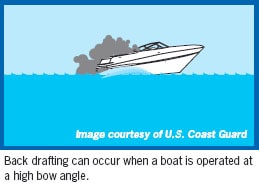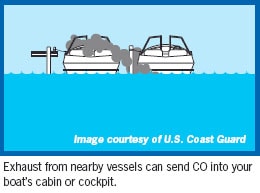Prevent Carbon Monoxide Poisoning on Your Boat
Gasoline-powered engines on boats, including onboard generators, produce carbon monoxide (CO), a colorless and odorless gas that can poison or kill someone who breathes too much of it.
How CO Can Build Up In a Boat

Larger boats, such as houseboats, sometimes have generators that vent toward the rear of the boat. This venting poses a danger of CO poisoning to people on the rear swim deck or water platform. On larger boats CO builds up above the water near the water platform. CO that builds up in the air space beneath the stern deck or on and near the swim deck can kill someone in seconds.
Traveling at slow speeds or idling in the water can cause CO to build up in a boat’s cabin, cockpit, bridge, and aft deck, or in an open area. Wind from the aft section of the boat can increase this buildup of CO.
Back drafting can cause CO to build up inside the cabin, cockpit, and bridge when a boat is operated at a high bow angle, is improperly or heavily loaded, or has an opening that draws in exhaust.
Symptoms of CO Poisoning
The most common symptoms of CO poisoning are headache, dizziness, weakness, nausea, vomiting, chest pain, and confusion. High levels of CO inhalation can cause death. CO poisoning can also cause you to pass out and fall into the water and drown. A person who is sleeping or intoxicated can die from CO poisoning before ever having symptoms.
How to Prevent CO Poisoning on Boats

Install and maintain a working CO detector listed by Underwriters’ Laboratories (UL) as appropriate for marine use inside the boat.
- Properly install and maintain all fuel-burning engines and appliances.
- Educate all passengers about the signs and symptoms of CO poisoning.
- Swim and play away from areas where engines vent their exhaust.
- Watch children closely when they play on rear swim decks or water platforms.
- Never block exhaust outlets. Blocking outlets can cause CO to build up in the cabin and cockpit areas–even when hatches, windows, portholes, and doors are closed.
- Dock, beach, or anchor at least 20 feet away from the nearest boat that is running a generator or engine. Exhaust from a nearby vessel can send CO into the cabin and cockpit of a boat.
If you think a person on your boat has CO poisoning move him or her to fresh air right away and contact the nearest emergency services.